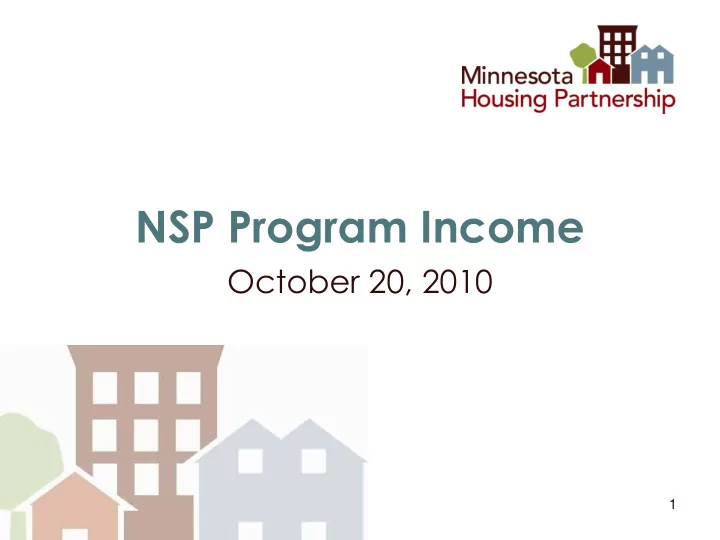

NSP Program Income October 20, 2010 1
General NSP Definitions www.mhponline.org • Grantee : a public agency or non-profit with a direct HUD contract. • Sub-recipient (Sub-Grantee): a public agency or non- profit that is a partner of the grantee who administers a portion of the program on a grantee’s behalf or the entire program. • Developer : a non-profit or for-profit doing the deals, they must have site control and are taking ―risks‖ for which they earn a profit. • Program Income: funds coming back to the Grantee or Sub-recipient that has invested NSP funds in a project, program or activity. 2
General Principles www.mhponline.org • NSP Program Income follows the rules of the Community Development Block Grant (CDBG) Entitlement Program for program income and has to meet all of the NSP rules that came with the original NSP funds. 24 CFR 570.500 (a) • Revenue received by a state, local government, or sub- recipient that is directly generated from the use of NSP funds constitutes program income. • There is NO 25% set-aside rule with NSP program income. • Program income was different for NSP 2. Previously, all grant & program income funds must be spent in 3 years. 3
General Principles (cont.) www.mhponline.org • This requirement meant that NSP 2 Grantees needed to increase the size of its program to spend both the award & program income earned. • CHANGED in the NSP 3 guidance to align with NSP1 requirements. 4
Program Income Exclusions www.mhponline.org • Any income received in a single program year by a grantee and all its sub-recipients, if the total amount of such income does not exceed $25,000. • For NSP, the term ―program year‖ means the 12 month period following the NSP program start date specified by the HUD grant award. • Grantees must track & aggregate NSP revenue (including revenue received by its sub-recipients) on an annual basis to determine if this exclusion applies. 5
Combining NSP with other Funds www.mhponline.org • Revenue received from an activity that used both NSP & other funds, which results in program income. • Calculate NSP program income based on the same proportion that NSP funds represent to the total cost of the activity or its prorate share. Total Cost of Activity $300,000 NSP Funds 150,000 (50% of total) Other Funds 150,000 Revenue $250,00 NSP Program Income 125,000 (50% of total) 6
NSP Bridge Notice www.mhponline.org • Program income received after July 30, 2013 doesn’t have to be returned to HUD. • Revenue received by a private individual or other entity that is not a sub-recipient is not required to be returned to the grantee. • NSP program income must be tracked in perpetuity and must be used to fund NSP eligible activities. • CDBG program requirements are still applicable to income directly generated from the use of NSP funds. 7
First In First Out Rule (FIFO) www.mhponline.org • Two Exceptions: 1. Grantee allows a sub-recipient to retain its program income earned. The sub-recipient must spend the program income before requesting additional NSP funds from the Grantee. However, the Grantee doesn’t have to wait for the sub -recipient to spend its program income before paying NSP eligible expenses for another program/project activity. 2. Revolving Loan Fund (RLF): program income that is deposited into a RLF, which has a specific designated purpose (e.g. acquisition, new construction). Program income earned from a RLF doesn’t have to spent first as these funds have a specific targeted purpose. 8
www.mhponline.org NSP Program Income • Proceeds from the sale or lease of property acquired/redeveloped/rehabilitated with NSP funds • Principal and interest payments on loans made from NSP funds • Recaptures on sales of homes pursuant to enforcement of NSP affordability requirements 9
Sale of NSP Acquired Property www.mhponline.org • Net proceeds from the sale of NSP acquired property is program income. – Sale of NSP acquired property that had been operated as rental housing – Sale of NSP acquired property held in a Land Bank. • Subsequent Sale by Initial Purchaser – Sale of housing used as a primary residence — the applicable recapture/resale provisions apply 10
Sale of NSP Acquired www.mhponline.org Property (cont.) • Subsequent Sale by Initial Purchaser – Sale to an unrelated entity controlled by the original entity, all program income provisions continue. – Sale of land banked properties is considered program income, regardless of when it is received. 11
Program Income Example: www.mhponline.org • Multifamily property is acquired & renovated using NSP funds and then sold to a private owner. • The sale proceeds are program income. • The rents received by the private owner are not considered program income. • Affordability requirements will apply. 12
www.mhponline.org Questions? 13
Recommend
More recommend